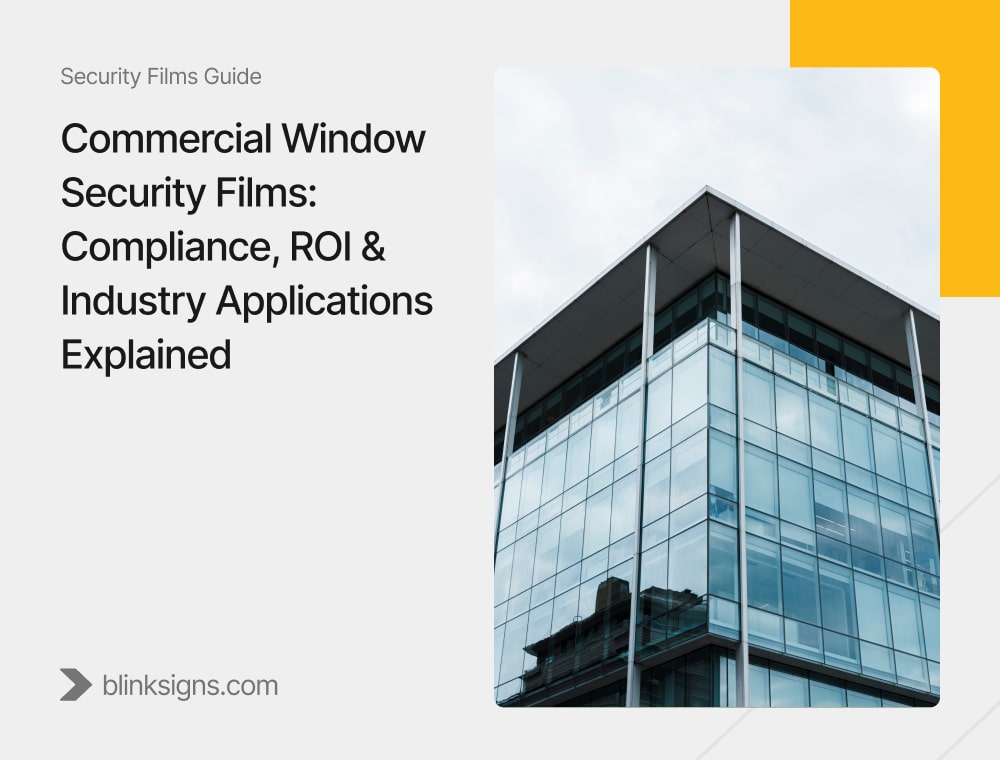
Commercial Window Security Films: Compliance, ROI & Industry Applications Explained
The Compliance Era of Building Safety
Safety standards for commercial buildings are evolving faster than ever. From glass impact ratings to energy codes, a facility manager’s decision now affects compliance, liability, and insurance costs. Commercial window security films have become a quiet but essential part of that equation — a security upgrade and a regulatory safeguard.
At BlinkSigns, we’ve seen a clear trend: businesses no longer install films for break-in protection. They’re doing it to pass building inspections, qualify for insurance incentives, and align with sustainability goals. This guide unpacks how compliance, ROI, and long-term performance define the new generation of security film strategies for businesses across industries.
1. Compliance & Building Code Requirements
The safety glazing category is heavily regulated under ANSI, CPSC, and ICC standards — each defining what “safe glass” truly means in a commercial environment. Security films allow property owners to meet these codes without replacing existing glazing systems, making them a preferred compliance retrofit.
| Regulation | Purpose | Application in Commercial Buildings |
| ANSI Z97.1 | Defines safety glazing impact resistance. | This standard ensures that glass won’t produce sharp shards during human impact, making it essential for schools, offices, and healthcare facilities. |
| CPSC 16 CFR 1201 | Federal consumer safety standard for architectural glazing. | Indoors, side panels and partitions are required in public facilities. |
| ICC Building Codes | The International Code Council establishes the integrated safety guidelines. | Used for local permit approvals and final inspections. |
| OSHA Glass Safety Guidelines | Protects employees from potential glass hazards. | Mandates reinforced glazing or protective films in work areas. |
| NFRC Energy Ratings | Defines solar performance and visible light transmission. | Important when using dual-purpose solar or tinted security films. |
Complying with these codes is more than a checklist — a business obligation. Facilities that fail to meet ANSI or CPSC ratings risk failed inspections or denied insurance claims after glass-related accidents. A certified security film installation helps bridge the gap between outdated glass systems and modern safety laws, especially in legacy buildings or multi-tenant properties.
2. Insurance & Liability Benefits
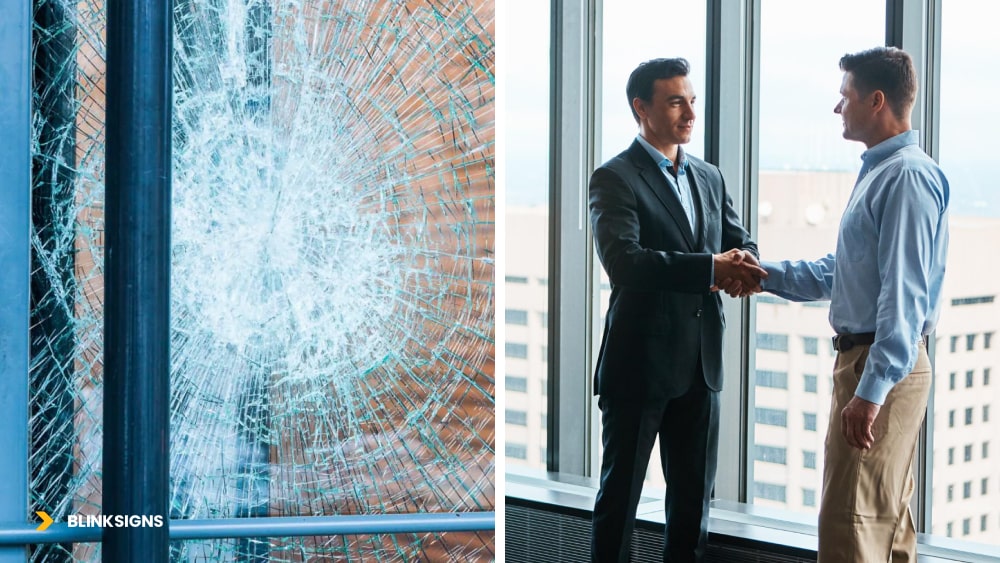
Insurance & Liability Benefits
Insurance providers are increasingly rewarding preventive risk management — and window security film has become a recognized part of that strategy. Many insurers classify it as a “mitigation upgrade”, offering lower premiums for businesses that demonstrate proactive safety measures.
When glass fails, so does liability coverage. A single injury from flying shards can trigger OSHA investigations and workers’ compensation claims. Security films reduce that exposure by ensuring compliance with impact-resistant glazing standards and minimizing potential personal injury.
Here’s how certified installations affect insurance performance:
- Risk Category Adjustment: Buildings with ANSI-certified films may qualify for lower property risk classification.
- Claim Reduction: Studies from safety associations show a measurable drop in glass-related claims in facilities using laminated or filmed glazing.
- Eligibility for Credits: Some commercial insurance programs offer 5–10% premium credits for properties with recognized safety upgrades.
- Legal Protection: Meeting CPSC and ICC codes helps prove “reasonable care” — a key factor in defending against negligence claims.
For corporate facility managers, the ROI extends beyond cost savings. Certified safety films lead to better building inspections, increase employee confidence, and help meet ESG (Environmental, Social, and Governance) goals — all of which affect how investors view the company and its long-term reputation.
3. Operational ROI: Safety That Pays for Itself
The financial logic becomes clear when decision-makers look beyond the upfront cost of security films. These films protect people and preserve assets, reduce energy consumption, and extend glazing life — all measurable ROI factors.
| ROI Driver | Impact on Operations | Estimated Payback |
| Accident & Downtime Reduction | Fewer glass-related injuries mean lower insurance payouts and minimal business interruption. | 12–18 months |
| Energy Efficiency | Solar-rated films reduce HVAC load by up to 15%. | 2–3 years |
| Asset Preservation | UV rejection protects interiors, signage, and equipment. | Continuous |
| Insurance Credits | Lower premiums for ANSI-certified safety upgrades. | Annual savings cycle |
| Brand & Employee Perception | Demonstrates a commitment to workplace safety and sustainability. | Intangible ROI |
Sustainability and compliance KPIs increasingly align with modern security film projects. Facilities pursuing LEED certification or ESG disclosure reporting often include window-film retrofits under energy and safety enhancement measures. By improving comfort and reducing risk, these films deliver both tangible and reputational returns — an ROI that compounds year after year.
4. Procurement & Rollout Strategy
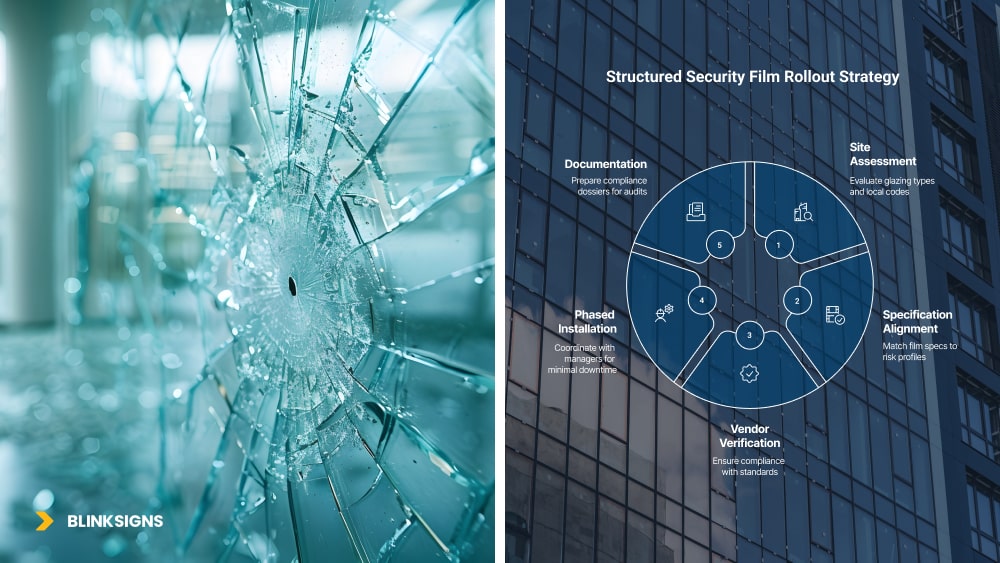
Procurement & Rollout Strategy
For organizations managing multiple locations — from retail chains to healthcare networks — deploying security films requires more than a purchase order; it demands a structured rollout strategy.
Step 1 – Site Assessment & Risk Profiling
BlinkSigns begins by evaluating glazing types, exposure zones, and local compliance codes. Each building receives a risk index ranking based on traffic density, geographic weather patterns, and burglary statistics.
Step 2 – Specification Alignment
Instead of generic film categories, we match specifications to risk profiles. For instance, a corporate office might need six mil solar-rated safety film, while a warehouse near coastal regions requires 12 mil impact-resistant film that satisfies ASTM E1886/E1996 storm-impact criteria.
Step 3 – Vendor & Compliance Verification
We source from certified manufacturers such as 3M Commercial Solutions and XPEL Architectural Division, verifying each batch for ANSI Z97.1 and CPSC 16 CFR 1201 compliance before installation.
Step 4 – Phased Installation & Performance Tracking
Our crews coordinate with building managers to minimize downtime. Each completed phase undergoes post-installation adhesion testing and optical inspection, ensuring long-term durability and visual clarity.
Step 5 – Documentation & Audit Readiness
Every project concludes with a compliance dossier — warranty data, safety certificates, and inspection logs — helping facility teams prepare for fire-marshal or OSHA audits without additional paperwork.
This structured approach makes multi-site implementation predictable, budget-controlled, and fully auditable — crucial for enterprise clients managing dozens of properties under one corporate umbrella.
5. Industry-Specific Applications of Commercial Window Security Films
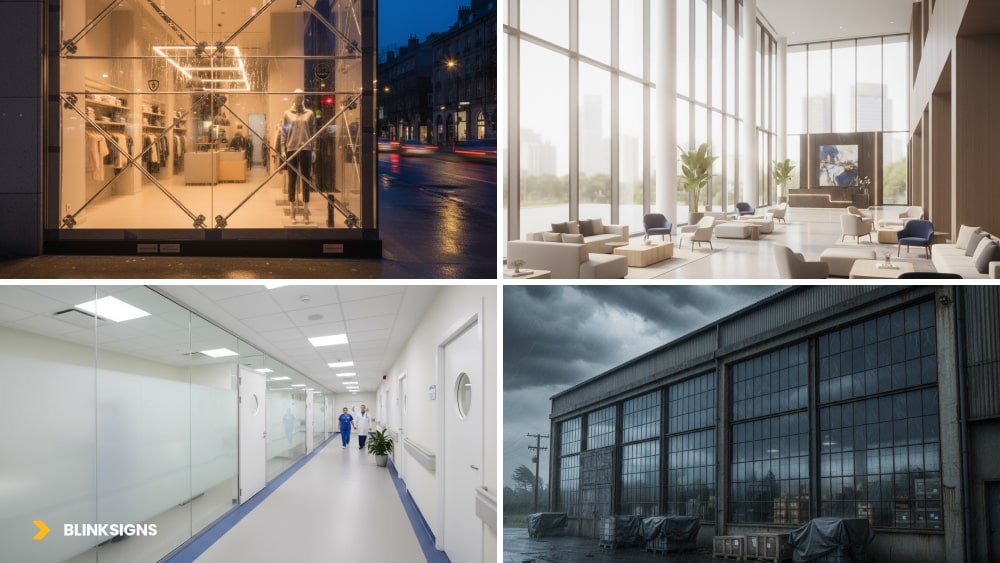
Industry Specific Applications of Window Security Films
While all businesses benefit from security films, each sector faces distinct operational risks and regulatory nuances.
🏬 Retail & Banking
High-visibility storefronts face the dual challenge of customer appeal and theft deterrence. ANSI-rated films maintain transparency while reinforcing glass against smash-and-grab incidents. Financial institutions often integrate them into branch security protocols to meet insurer underwriting conditions.
🏨 Hospitality & Corporate Offices
Hotels and office towers prioritize comfort and aesthetics. Solar security films reduce glare in guest areas and improve HVAC efficiency across glass façades. Decorative variants ensure brand consistency across chains while maintaining ICC-compliant safety glazing.
🏥 Healthcare & Education
Hospitals and schools must meet stricter impact-resistance and privacy requirements. Films in these environments often combine frosted finishes for confidentiality with CPSC-compliant safety ratings. In emergency zones, they also prevent hazardous glass scattering.
🏭 Industrial & Logistics Facilities
Warehouses and distribution centers face high wind loads, equipment vibration, and storm exposure. Severe-weather security films (8–12 mil) and edge-anchoring systems keep people and property safe while meeting OSHA 1910.
Across every sector, these implementations share one goal: compliance without compromise. Businesses gain a safer, more energy-efficient environment while preserving architectural design integrity.
6. Trends & Future Outlook
The commercial glazing market is evolving rapidly, with some types of security films now at the intersection of safety, energy efficiency, and innovative technology. What was once a passive safety layer is becoming an intelligent part of building performance systems.
- Smart & Switchable Films
Enterprises are investing in electrochromic (smart glass) films that change opacity with a remote command, merging privacy with light management. These are particularly popular in corporate boardrooms, healthcare observation areas, and executive offices where flexibility and confidentiality matter. - Integration with Building Automation Systems (BAS)
Future-ready window films are being designed to sync with IoT-based building management platforms. These systems monitor indoor temperature, lighting, and security, automatically adjusting film tint levels to balance comfort, privacy, and energy load. - Sustainability & ESG Alignment
As sustainability reporting becomes mainstream, security films are now recognized under LEED v4 categories for energy optimization and material efficiency. By lowering HVAC loads and improving occupant comfort, they directly support Scope 2 emission reductions — a metric increasingly tracked in corporate ESG disclosures. - Regulatory Momentum
More states are adopting mandatory safety glazing regulations in public-facing buildings. This shift means security films will soon become an upgrade and compliance requirement, particularly for educational, medical, and retail environments.
These trends highlight a clear point: security films are changing from responding to safety issues to becoming essential tools for meeting regulations, influencing how modern buildings function and maintain their worth.
7. The BlinkSigns Advantage
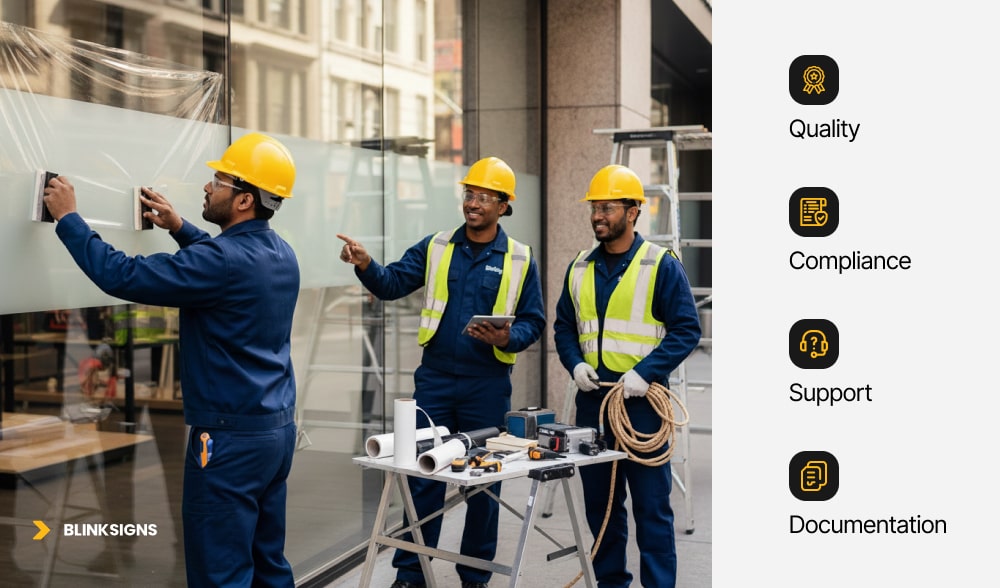
BlinkSigns Expertise in Security Film Solutions
At BlinkSigns, compliance and performance are never afterthoughts — they’re built into every installation. Our process begins with understanding your property’s risk profile and ends with a fully documented, certified installation that aligns with your operational goals.
What Sets BlinkSigns Apart
- Code-First Expertise: Before the first film is applied, every project is mapped against ANSI, CPSC, and ICC glazing standards.
- Manufacturer-Verified Partnerships: Authorized installer of leading brands like 3M, XPEL, and Madico, ensuring verified performance and warranty coverage.
- Multi-Site Consistency: Centralized rollout management for retail chains, hospitals, and corporate campuses across states.
- Compliance Documentation: Delivery of inspection-ready dossiers for OSHA and fire-marshal audits.
- Post-Install Support: Annual inspection and performance reporting to maintain warranty validity and building safety certifications.
Businesses choose BlinkSigns not only for installation precision but for long-term reliability. Each project becomes part of a broader safety strategy that supports insurance audits, sustainability reporting, and operational ROI — all while protecting employees and customers.
FAQs
Q1. Do commercial security films help businesses meet building codes?
Yes. Certified films that comply with ANSI Z97.1 and CPSC 16 CFR 1201 standards qualify as safety glazing materials, helping buildings pass inspection without replacing existing glass.
Q2. How do security films contribute to ROI beyond safety?
They reduce insurance premiums, minimize downtime after incidents, and improve HVAC efficiency — delivering measurable cost savings within 18–36 months.
Q3. Can window films help a business qualify for LEED or ESG points?
Yes. Solar-control security films improve energy performance and occupant comfort, aligning with LEED v4 Energy & Atmosphere credits and ESG sustainability criteria.
Q4. What industries are most affected by glazing compliance laws?
Sectors like healthcare, education, retail, and hospitality face the strictest glazing safety mandates under state building codes and OSHA regulations.
Q5. How often should commercial security films be inspected?
A professional inspection every 12–18 months ensures edge integrity, adhesion quality, and compliance with warranty conditions. BlinkSigns offers scheduled maintenance plans for multi-site clients.
Conclusion
Modern business safety isn’t just about alarms or locks, compliance, resilience, and trust. Security films now stand at the heart of that ecosystem, offering tangible ROI, verified protection, and compliance peace of mind.
Whether you manage a single storefront or an enterprise portfolio, BlinkSigns delivers the certified expertise, national reach, and reliability needed to keep your properties protected and compliant.
📞 Talk to a BlinkSigns specialist today to assess your facility’s safety glazing requirements and build a compliant, future-ready solution that strengthens security and sustainability.